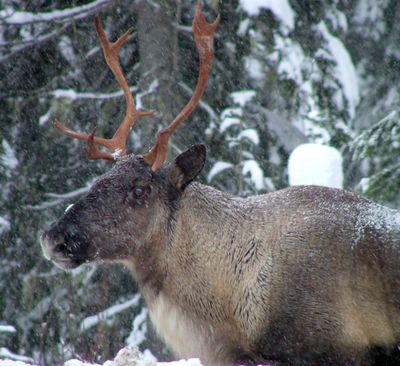Snowmobiler-commissioned study disputes caribou impact

PRIEST LAKE, Idaho – Protecting habitat for woodland caribou has cost North Idaho’s economy $26 million, with winter tourism in the resort area of Priest Lake taking the biggest hit, according to a study commissioned by the Idaho State Snowmobile Association.
The study calculated economic impacts back to 2005, when court-ordered trail grooming restrictions were put into place to keep a new generation of high-powered snowmobiles out of alpine forests and meadows favored by endangered caribou. It’s the second study released this summer seeking to measure the cost to local businesses of protecting caribou.
Though $26 million sounds like a large number, it actually represents just 2 percent of North Idaho’s economic activity, said one of the study’s authors, Charley McKetta of Forest Econ in Moscow, Idaho. However, Priest Lake’s fragile tourism economy experienced a disproportionate share of the impacts, he said.
“We looked at all the winter hotel occupancy rates over time by month,” McKetta said. “You can see how the resort business has just curled up.”
That’s not news to Ed Porter, who owns Priest Lake Power Sports. Prior to the caribou restrictions, the shop rented out 30 snowmobiles each weekend from Christmas through March, with visitors spending $275 per day on rentals.
“Now, I’m lucky if I rent out five once per month,” Porter said.
Part of the problem is perception, he said. The Priest Lake area still has 400 miles of groomed trails and alpine meadows where snowmobilers can play in deep powder. But seven years of seasonal restrictions to protect caribou habitat, including Forest Service closures of popular backcountry areas, has soured many Inland Northwest snowmobilers, Porter said.
They don’t feel wanted so they are taking their expensive machines to other resort destinations, Porter said.
The Idaho State Snowmobile Association’s recently released study comes on the heels of an analysis done for the U.S. Fish and Wildlife Service, which said that designating 375,000 acres as critical caribou habitat in North Idaho and northeast Washington would have minimal economic impacts.
Agency officials said the critical habitat designation is largely a formal step that recognizes habitat areas already protected for caribou. Their analysis projected a $1.5 million economic impact over the next two decades, primarily to the timber industry.
No future winter tourism impacts were anticipated; they’ve already occurred, the analysis concluded.
About 46 caribou are believed to remain in the South Selkirk herd, with most of the herd found north of the Canadian border. Alpine forests undisturbed by motorized use are vital to caribou survival. When winter sets in, the docile animals use their broad hooves like snowshoes, heading to austere peaks to evade predators and feed on lichen growing on old-growth trees.
The two studies were done quite differently, which makes them difficult to compare, McKetta said. His study included the economic costs of foregone trips to Priest Lake, including lost hotel bookings, restaurant receipts and gasoline purchases.
It also said that 46 logging and trucking jobs could be lost, mainly in the Priest Lake area.
“You’ve got to look at who commissioned the study,” said Mike Petersen, executive director of the Spokane-based Lands Council, who suspects that the recession could explain some of the drop in revenue.
“Look what’s happened in the last four years: The economy has really tanked, and it’s tanked in ways that have kept people from traveling to places like Priest Lake,” he said.
The Lands Council was part of a lawsuit filed by environmental groups; its settlement required the U.S. Fish and Wildlife Service to designate critical caribou habitat.
As recently as 20 years ago, caribou were seen in some areas around Priest Lake, Petersen noted.
During the 1990s, Priest Lake businesses began courting snowmobilers, developing a winter recreation marketing plan to complement the area’s summer tourism on the lake. Advances in snowmobile technology, meanwhile, allowed the machines to access higher, steeper terrain, encroaching on caribou habitat, Petersen said.
Recovering the caribou population will take decades, but it will never happen without safeguarding the high-elevation, old-growth habitat they require, he said.
Petersen said he’s sympathetic with Priest Lake businesses that lost revenue, but he thinks a new marketing strategy would be the most proactive approach. “There’s still miles and miles of snowmobiling opportunity up there,” he said.
Rick “Hutch” Hutchins is a partner in the Korner Club Restaurant and Bar in Priest Lake. For the past five years, it’s been a summer-only operation.
“We lost $30,000 to $40,000 every winter trying to stay open with a skeleton crew,” he said.
For Hutchins, it’s hard to delineate what role the caribou restrictions versus the economy played in the decline of his winter business. But the lost revenue from winter tourism definitely hurts, he said.
“It does impact the small-business income,” Hutchins said. “The little business is the one that gets hurt.”
Porter, of Priest Lake Power Sports, said he’s reduced his staff from five full-time and two part-time employees to two employees.
“It’s quite possible that we could reach a point where it is no longer possible for our family to keep our (business) open,” Porter wrote in a letter to the U.S. Fish and Wildlife Service.
Closing the dealership would have a negative ripple on Priest Lake’s resorts, Porter said. They rely on the shop for snowmobile and personal watercraft rentals to augment their lodging packages, he said.